
Understanding the right way to frame your original pastel is an important element in preserving it over time. Numerous articles have been written about easy, inexpensive ways to frame a pastel in an attempt to keep costs down, but sometimes cutting corners can be a bigger liability than an asset. Custom framers spend a great deal of time reading, researching, and attending framing classes to remain up to date on materials and techniques to best handle all art mediums. Thirty five years ago it was state-of-the-art to use corrugated cardboard and masking tape to frame any art. Today those acidic and invasive materials have been replaced by neutral pH backing boards and starch paste hinges or corner pockets.
Custom framing specifically designs a presentation to best enhance each unique piece of fine art. Prices are affected by the materials selected, as a rag mat and acid-free (AF) foam center board costs more than paper mat with chip board backing. Current framing trends prefer preservation materials and reversible techniques for all original and collectable art, so use of regular clear glass and paper mat is not the norm. Though your framing professional may be very well skilled in preservation framing practices, he/she may not routinely frame pastels, so do not hesitate to explain how your pieces need to be handled and stored prior to framing completion.
Museum Quality Framing
Acid-free, archival, and museum quality are three terms used in marketing to convince the consumer a product is high end and nonharmful. Acid-free is a chemistry term meaning the material is no less than 7.0 on the pH scale of 0-14, with 0-7 indicating acidity and 7-14 indicating alkalinity. Though a level of 7.0 is considered neutral, most framing materials inhabit an alkaline range of 7.5-9.5 pH, which includes most alpha cellulose and rag mats (diagram 1). Museums and professional framers select materials that are acid neutral, nonstaining, and nondeteriorating over time, so that the art may be removed at a future date with no harm caused by any framing materials.

The terms archival, conservation, and preservation are used interchangeably in professional framing, referring to the highest level of protection possible. Archival is a nontechnical term used to suggest a material, technique or process which is permanent, durable, and stable over time. More literally it refers to items properly stored in a climate controlled archive. If your framer uses the terms acid-free or archival have him define for you.
Museum—conservation, or preservation—quality is a marketing phrase used to imply that all materials reflect what would be chosen for use in a museum for high value collectables. More correctly referred to as preservation framing it means the use of only reversible methods and inert materials that will not create a new chemical reaction and change the art over time. Everything from UV-glass to neutral pH dust cover must be neutral to qualify as preservation framing, anything less is not. When paying for preservation treatment the dust cover must never be brown or black Kraft paper, that would be the first indication that preservation materials might not have been used throughout.
Mounting and Hinging
A custom framer should never agree to dry, wet, or pressure-sensitive mount a finished pastel to any backing board, and should never offer spray adhesive. They may suggest dry mounting your raw Wallis sheets of sanded paper to a backing board prior to the application of pastel pigments next time (photo 1). The mount board should be at least a 4-ply rag board, though 8-ply is more rigid and a better choice. Foam center board is not a good choice as a mounted backing because it can easily dent or bend during pigment application.
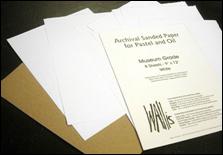 Photo 1
Photo 1
Though the pastel paper is neutral and archival, it has been packaged with a highly acidic chipboard backing (lower L).
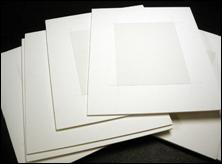 Photo 2
Photo 2
Here they have been mounted to 15x18" 4-ply white rag board using the permanent tissue adhesive called ColorMount.
The pastel paper should be mounted to the board with additional border 3"- 4" boarder to accommodate mats and larger finished frame size (photo 2). If the borders are not wide enough for the desired frame, a sink mount may be constructed to enlarge the rigid pastel art (photo 3). A set of ¾" edge strips are attached to a new backing to support and suspend the mounted pastel. Once the rigid pastel is positioned it will be flush with the edge strips and ready for matting (photo 4).
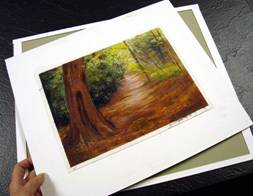 Photo 3
Photo 3
The pastel paper was mounted to a backing smaller than the desired frame size after completion.
A set of ¾" edge strips are attached to a new backing to support and suspend the mounted pastel.
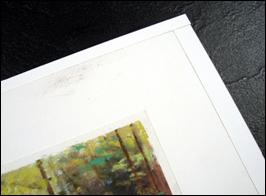 Photo 4
Photo 4
The 4-ply pastel art drops into the border and since the strips are also 4-ply the new backing is all the same thickness.
If the art is on unmounted paper then a noninvasive corner pockets, or starch hinges are possible for mounting. Linen tape may be used as a book hinge to connect the window mat to the backing board (photo 5), but should never be used for hinging art. Hinges must be the weakest link so they tear or break before damaging the art, and linen tape is too strong.
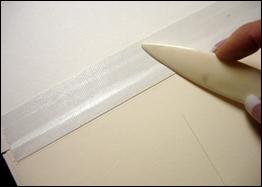 Photo 5
Photo 5
Linen tape used for book hinging the mat to backing board.
Mat Colors and Emphasis
Vibrant mat colors may go well with the décor of a home, but framing should be for the art. Mat colors for pastels generally remain understated and neutral, never visually distracting the viewer (photo 6). If darker colors are chosen they should be kept narrow and used as inner mats to help draw the eye in. Highly textured of glossy mats should be avoided for pastels as they fight for attention (photo 7). This sample corner is the mat that was removed from the sampler pastel.
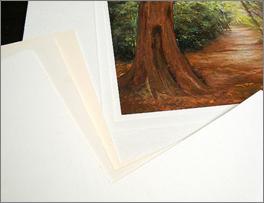 Photo 6
Photo 6
Darkest color should be closest to the art to help draw the eye in.
White is the most popular neutral of which there are many soft whites and creams to choose from. Pure bright white can be harsh and attract visual attention away from the art. Softer pearl white, natural white, antique white and cream mats are best with the darkest of the neutrals most often used as the innermost liner to help draw the eye into the art (photo 8).
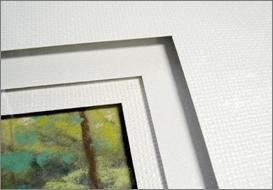 Photo 7
Photo 7
Three high gloss canvas and patterned mats in bright white are too distracting for any soft pastel.
The bottom mat has a 4-ply space behind lifting it from the pastel and there is a ⅜" reveal to the middle mat, which has a ½" reveal to the top mat.
All are cut with reverse bevels.
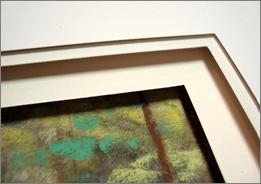 Photo 8
Photo 8
(R to L) Rag mats of Pearl White, Natural White, and Antique White.
Spacing
Though a single mat with a deep spacer is adequate for a pastel (diagram 2), it is far better to have a double or triple mat to keep the glazing farther away from the art (diagram 3). The innermost mat should be lifted off the pastel by use of an 8-ply spacer mat, ⅛" foam center board, or commercial spacers.Alcan Fome-Cor, Bienfang Foam Board, and Bainbridge Artcare Foam Board are all types of neutral surface paper foam center board.


Use of spacers in a frame package adds depth and intensity to the design and physically helps draw the viewer into the art. All window mats should be cut as reverse bevels to prevent any pastel dust from landing on the flat visible bevel edges. This too aids in the illusion of depth.
Glazing
Glazing refers to either glass or acrylic sheeting, and glass should always be a part of framing a pastel. UV-glazing—glass or acrylic—blocks 97% of the harmful UV rays that fade pigments and papers. Regular glass is fast becoming a distant memory with UV-Conservation Clear and Museum glass becoming the two top choices for custom framing.
Acrylic sheets are not recommended for pastels because of their static electricity, with Plexiglas being a brand specific acrylic sheet. Acrylic is available as UV- and abrasion resistant but at a very much higher price. Anti-static cleaners and rags are designed to reduce static charges during the basic cleaning and assembly, but do not reduce static on a day-to-day basis, therefore static cannot be avoided. Acrylic should be avoided unless the pastel is unusually large and weight is an issue.
Protective spray coatings are currently being promoted in conjunction with commercial panels in lieu of traditional glazed framing practices. But it should be stressed that fixatives appear to be only short term effective and conservators have unanimously cautioned that such coatings cannot take the place of proper glazing of the art. No amount of fixative will ever protect any original art from a glass of splashed red wine or soda.
Final Assembly
The basic pastel package includes frame; UV-glass; acid neutral, AF, or buffered mat(s); spacers to keep the mats from touching the pastel; backing and/or filler boards; dust cover; D-rings and wire at 60-degree angle with slack for two hangers; and bumpers to lift the frame, help stabilize it, and allow for air circulation (photo 9-10). For preservation framing light blue finishing paper or white Tyvec is favored. Black dust covers are carbon based, which ghost off onto a light colored walls, and leave scuff marks. Dust covers are there to help protect the pastel from moisture, ozone, and pollutants. It deters insects a little, but they will eat through paper.
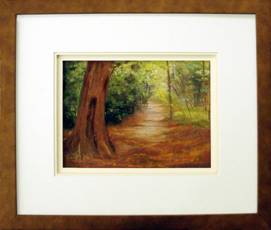 Photo 9
Photo 9
A mottled copper finish wood frame emulates the rich colors of the path and the tree. The triple mat places the darkest neutral as the inner mat helping draw the eye into the art, while the middle and top mats match worn path and highlights in the pastel.
"A Path In France" is shown courtesy of Redding, CA artist Gwen Walker-Strahan.
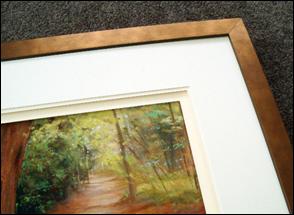 Photo 10
Photo 10
Triple reverse bevel mats with added spacers.
The selected frame should always be deep enough for all layers including spacers. A framer should not suggest a moulding that requires an extension to protrude out the back to accommodate all the layers. There are always mouldings deep enough for any design and it is the framer's job to find one for you.
Qualified Framers
The easiest way to assure yourself of an accredited frame professional is to look for the initials CPF (Certified Picture Framer) behind their name. This designation is awarded by the Professional Picture Framers Association (PPFA) after a framer has illustrated his/her working knowledge of all phases of custom framing and care of art and collectables.
Most professional framers have a full working knowledge of how to best protect and enhance your pastel. Fixatives may only be applied by the artist and any reputable framer will never agree to apply said fixative to any art. It is also very likely they will suggest spacers and reverse bevels to accommodate pastel dust and glass even if you have used a final fixative and Ampersand Pastelbord. There is truly no place for float frames with original pastels, even though they are occasionally used. When custom framing, ask questions throughout the design process to better learn about framing and in turn and teach your framer about the art of pastel. Knowing how to speak framer will best protect your art.
END
Copyright © 2010 Chris A Paschke
The sampler pastel "A Path In France" is shown courtesy of Redding, CA artist Gwen Walker-Strahan.
This original pastel has been disassembled and reframed to change mat colors, mat proportions, and frame to better enhance it.
Framing Definitions
Acid-free: A chemistry term used for materials 7.0 + 5% on the pH scale of 0-14, that are nonstaining and nondeteriorating when tested, but this can change over time.
Acid Neutral: Any inert material with an unbuffered pH above 7.0 and no alkaline reserve.
Archival: A nontechnical term used to suggest a material, technique or process is permanent, durable, and stable over time, as would be used in a museum or archive.
Buffering: The addition of calcium carbonate during papermaking as an alkaline reserve, which raises the pH level to counteract acidic contamination.
Fome-Cor: A specific name brand of foam center board manufactured by Alcan Industries.
Foam center board: The correct generic name for boards with a foam center and assorted face papers of 100% cotton, neutral pH (AF), and clay coat varieties, available in white and black.
Museum Quality: Materials that are inert, stable, and suitable for housing art and artifacts as would be used in a museum. Sometimes referred to as museum treatment.
Museum Mounting: Use of reversible hinges, corner pockets or edge strips to mount the art to a 4-ply cotton rag backing board.
Preservation Framing: Only reversible methods and neutral, stable, inert materials are used in all framing techniques, from glass to dust cover.
Rag Board (rag mats, museum board): Mat board made of cotton linters containing alkaline reserve.
Reversible: Materials and techniques that may be undone without altering the art in any way thus returning to its original condition.
Reverse Bevel: An invisible bevel cut to the inside of the mat window.
Spacer: A layer of foam center board, 4 or 8-ply rag board, or commercial extruded polyester strip that separates layers and adds depth.
For more articles on mounting basics look under the mounting section in Articles by Subject.
Additional information on all types of mounting is found in:
The Mounting and Laminating Handbook, Second Edition, 2002,
The Mounting And Laminating Handbook, Third Edition, 2008 and
Creative Mounting, Wrapping, And Laminating, 2000 will teach you everything you need to know about getting the most from your dry mount equipment and materials as an innovative frame designer.
All books are available from Designs Ink Publishing through this website.
Chris A Paschke, CPF GCF
Designs Ink
Designs Ink Publishing
785 Tucker Road, Suite G-183
Tehachapi, CA 93561
P 661-821-2188
chris@designsinkart.com